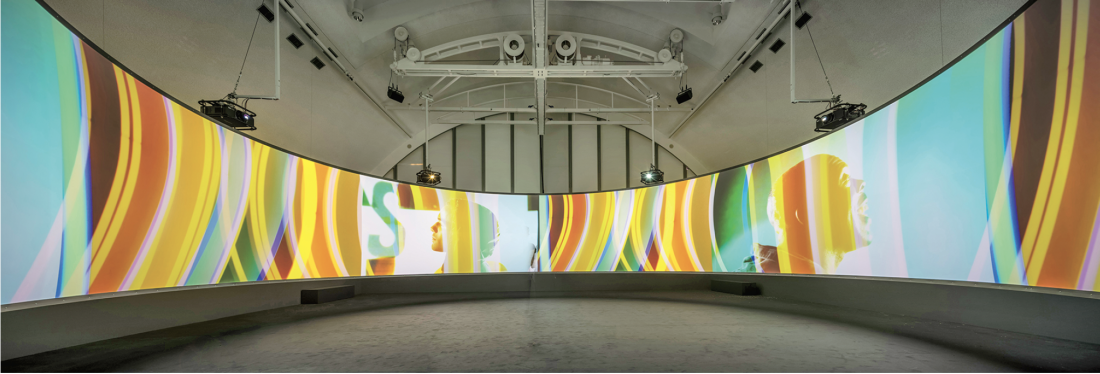Doug Aitken
California-born, LA- and New York-based Doug Aitken has had a high European profile of late: his collaborative extravaganza, “Station to Station,” which originally took place last year on rail journeys across the States, was reprised at London’s Barbican during July. His London gallery, Victoria Miro, showed him in parallel. And then there was a substantial survey in Germany.
The unusual space of Frankfurt’s Schirn Kunsthalle proved well-suited to a highly focused, almost hieratic retrospective with six components—each of which received a separate essay in the show’s substantial catalogue. The circular courtyard held the biggest version yet of his sound sculpture Sonic Fountain, whereby we saw and heard—electronically and acoustically magnified—water dripping into a basin formed from sand and gravel. The result looked like a building site—especially as there was a real building site just yards away.

Doug Aitken, exhibition view, SONG 1, 2012/2015. © Schirn Kunsthalle Frankfurt, 2015. Photo: Norbert Miguletz. Courtesy Schirn Kunsthalle Frankfurt.
Inside, the ground floor held the multichannel video installation SONG 1, 2012/15, originally developed for the facade of the Hirshhorn Museum in Washington DC. There it was projected onto both sides of a cylindrical screen suspended from the ceiling, so that visitors could stand inside the installation to watch and hear many different versions of the old standard “I Only Have Eyes For You.” Upstairs, the Kunsthalle has an exceptionally long run of linked galleries, which allowed Aitken to present three further film installations and a selection of decidedly cinematic sculptures in an uninterrupted walk-through. Black Mirror, 2011, tracks a young woman who is constantly on the move but seems stuck in life’s non-spaces—airport, hotel, highway, smartphone—without ever reaching its substance. The image appears as multiples and reflections in various sizes and orientations in a whole room environment. migration (empire), 2008, is presented simultaneously on three large screens set across the gallery space like a run of roadside advertising hoardings, showing a wide range of animals in hotel suites. The sequence ends with diamond sea, 1997, Aitken’s first multichannel video installation. For that, he spent several months filming what he calls the “phantom world” of the Namib Desert in the South-West Africa, in which industrial remnants of decaying diamond mines are set in a landscape which was for many years kept strictly secure.
All these components share certain features: they are visually spectacular, adopting the language of mainstream film and advertising. They emphasize the passing of time, but eschew narrative in favour of what might be taken as rather simple compilations of images for their own sake. It’s easy to enjoy them as the “psychological journey” Aitken says he hoped for, but also easy to be left wondering: why are we being shown this? Typically, Aitken’s films apply variations to a given content: the woman travels to many places; peacocks, bison, fox, rabbits, beaver, cougar, eagle, reindeer and owl appear in different hotel rooms; the same song is repeated in a blizzard of film references and musical styles.
And yet we are aware that at some deeper level, it is all the same. However we might strive on the surface—and in Aitken the surface is very seductive—you can’t escape from underlying patterns. So it is that the woman’s slogan in Black Mirror is: “exchange, connect, and move on”—she is doomed to remain at a superficial level. Nor is it obvious whether she’s on pleasure or business; the distinctions seem to have collapsed. What she represents, says Martin Herbert in his catalogue essay, is “an ideology of nomadism-as-disappearance: dislocating not only from others but also, ideally, from the self.” That’s why she says, “We don’t talk about the future much…Anything longer than a day is too much time.”

Doug Aitken, Sonic Fountain II, 2013/2015, installation in the rotunda of the Schirn. © Schirn Kunsthalle Frankfurt, 2015. Photo: Norbert Miguletz. Courtesy Schirn Kunsthalle Frankfurt.
In empire (migration), the variety of the animal kingdom runs into the standardization of the hotel room. Maybe that stands in for our inability to follow Noah in saving threatened animal species; these hotels won’t survive the flood. Or maybe, in what catalogue contributor April Lamm calls “a portrait of displacement,” we are all seen as alienated, like the migrant or animals cut off from the natural world. All the characters in SONG 2 may celebrate what Dominic Eichler, whose essay also appears in the Aitken catalogue, calls “an insane state” in which “the lover can see absolutely nothing except the beloved,” but there’s no evidence of happy coupling; rather, the characters appear lonely against the backdrop of the multitudes going about their lives. Diamond Sea isolates us in time, comparing the crawl of geological time with the compressed timescale of human endeavour, as represented by corporate enterprise.
What of the non-film works? Sonic Fountain II, 2013, is a technological reproduction of a natural phenomenon—i.e., what you expect of a filmset. Aitken’s light boxes act as isolated stills. The mirror sculptures use lettering bound to echo the Hollywood sign. Aitken intends to include the viewer by reflection so that “the intermediary is taken out of the equation and the viewer becomes the film.” So, somewhat perversely, Aitken’s non-film works reinforce the way his films suggest that life has become cinematic—and privileges spectacle over substance, casting us as isolated viewers, subsuming apparent variety within the formulaic. If that sense of alienation, consistent with the film works, is the overall thrust of Aitken’s worldview, it’s one which could be put across in a dry and indeed, alienating way. Aitken’s particular achievement is to have mastered the medium he deconstructs, enabling us to enjoy a sweet outer cake of entertainment even as we ingest a piquant filling of critique. ❚
Doug Aitken was exhibited at Schirn Kunsthalle, Frankfurt, from July 9 to September 27, 2015.
Paul Carey-Kent is a freelance art critic in Southampton, England, whose writings can be found at <paulsartworld.blogspot.ca>

